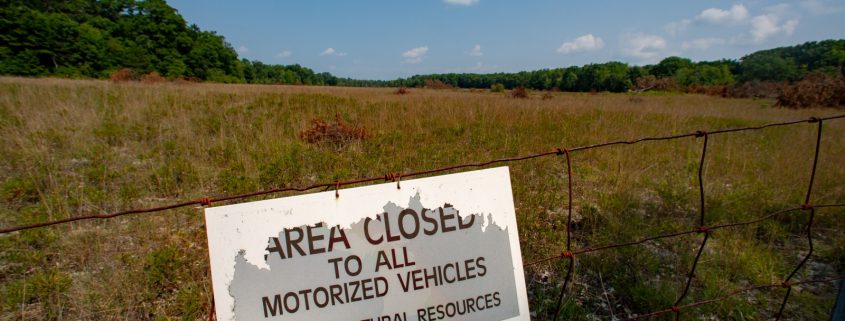Chemical contaminants called PFAS, toxic to humans at minuscule doses, are the tip of the spear for threats to groundwater in Michigan and nationally. Nitrates, industrial chemicals, and pathogens have been swept underground for decades. What else is in groundwater and seeping into drinking water? And what are the risks? Experts are calling the situation a “groundwater emergency.”
Three leading news organizations — Bridge, Circle of Blue, and Detroit Public Television’s Great Lakes Now — convened a virtual town hall October 1, that attracted a global audience to discuss the scope, complexities, and concerns about groundwater contamination in Michigan and across the nation.
Below are highlights from the town hall discussion, which featured a variety of groundwater experts and activists.

Photo © J. Carl Ganter/Circle of Blue
What’s the issue?
- Thousands of chemicals are in commercial use in the United States without knowledge of how they alter human bodies or ecosystems as a whole. These compounds, as well as other contaminants, have found their way into groundwater across the nation.
- About 43 percent of U.S. residents get their drinking water from groundwater.

Photo © J. Carl Ganter/Circle of Blue
What are PFAS?
- Per- and polyfluoroalkyl substances (PFAS) are a class of over 3,500 manmade chemicals that were developed after the second World War. Since then, PFAS have been incorporated into a dazzling range of products: firefighting foam, non-stick skillets, water-repelling jackets, stain-resistant carpets, floor cleaners, waxes, paints, insect traps, and more.
- Perfluorinated compounds, a subgroup of PFAS, are extremely persistent in the environment. They have been called “forever chemicals” because the carbon-fluorine bond that holds the molecules together is the strongest chemical bond.
- Additionally, some PFAS compounds, particularly perfluoroalkyl acids, are both mobile and bio-cumulative. This means they move quickly in groundwater, as well as build up in organisms faster than they are excreted.

Photo © J. Carl Ganter/Circle of Blue
Who are PFAS affecting?
- In addition to industrial production facilities, contaminated sites in the U.S. include military bases, fire stations, landfills, hospitals, and schools. All of these large institutions use foams or waxes or cleaners that contain the chemicals.
- The U.S. Department of Defense counts more than 400 active or closed bases with a known or suspected release of PFAS. The military has spent more than $210 million on cleanup so far.
- In Michigan, one of the worst-affected states, an estimated 1.8 million people have PFAS in their municipal water supplies. The level of contamination ranges from 1,800 parts per trillion (which was found in the city of Parchment) down to about two parts per trillion (found in the Grand Rapids water system).
- PFAS contamination in Michigan originated from numerous sites, including canneries, waste dumps, air bases, airports, and landfills.

Photo © J. Carl Ganter/Circle of Blue
What are the health risks of PFAS?
- The impact of PFAS on human health is still poorly understood.
- PFAS contamination has been linked to high cholesterol, testicular cancer, kidney cancer, ulcerative colitis, thyroid problems, developmental problems, and the potential for miscarriages.

Photo © J. Carl Ganter/Circle of Blue
What is the government doing to address PFAS contamination?
- In May 2016, the U.S. Environmental Protection Agency lowered its health advisory for two PFAS chemicals, PFOA and PFOS, to 70 parts per trillion in drinking water. The health advisory is not binding, and some public health researchers argue that it ought to be even lower.
- A handful of states, including Minnesota and Vermont, have issued health advisories at lower levels than the EPA, while New Jersey developed an enforceable drinking water standard for PFNA and PFOA.
- On September 26, Democratic Senator Gary Peters of Michigan convened a Senate subcommittee hearing on the federal lull in responding to PFAS. Based on that hearing, he believes Congress must:
1) Provide more funding to research the health implications of PFAS contaminants.
2) Push the EPA to set and regulate PFAS in drinking water.
3) Take accountability for PFAS use and contamination on federal properties. - The EPA is preparing a PFAS Management Plan, which they expect to release by the end of 2018. The agency is also developing groundwater cleanup standards for PFAS.

Photo © J. Carl Ganter/Circle of Blue
Who is going to clean up PFAS contamination?
- PFAS has not been designated as a hazardous substance by the EPA. Without this designation, the EPA has no authority to enforce cleanups or to fine the responsible parties.
- If a company has gone out of business or changed hands, a responsible party sometimes cannot be found. In that case, cleanup costs can be put on the taxpayer.

Photo © J. Carl Ganter/Circle of Blue
What other contaminants are threatening U.S. groundwater?
-
Coal ash – Also known as coal combustion residuals, or CCRs, coal ash is the byproduct of burning coal. Often stored in large pits near rivers or lakes, coal ash contains a variety of pollutants including arsenic, selenium, boron, and cadmium. These can be toxic to humans and aquatic life if released into groundwater or surface water.
-
Leaking septic systems – Bacterial waste, as well as chemicals used in homes, can be released into groundwater through leaking septic systems. In Michigan, an estimated 130,000 septic systems leak.
-
Agricultural practices – Chemicals and compounds used in agriculture, including nitrates and pesticides, are also contaminating groundwater.
A collaborative series produced by:
Furious and fearful, residents are asking a simple but urgent question: what’s in my water?
But PFAS are the tip of the spear for threats to groundwater in Michigan and nationally. Nitrates, industrial chemicals, and pathogens have been swept underground for decades — aquifers used as garbage cans. What else is in the groundwater? And what are the risks?
Kayla Ritter is a recent graduate of Michigan State University, where she studied International Relations and Teaching English to Speakers of Other Languages. She is currently based in Manton, Michigan. Kayla enjoys running, writing, and traveling. Contact Kayla Ritter









